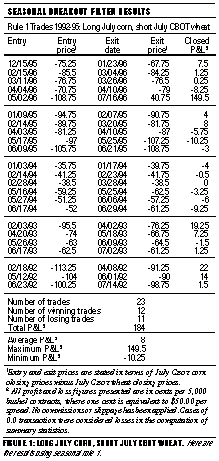Seasonal analysis is comparable to any other analytical method; we assume that future price movement will be similar to past price movement. When working with seasonal analysis, you review past price behavior within the framework of seasons or some other time element. Identify any recurring patterns and then anticipate that future price action will follow the historical patterns. Of course, all analysis, be it technical or fundamental, rests on using past measurements to predict future market behavior. Fundamental analysts -- grain analysts, for example -- base their forecasts on a number of historical fundamentals, including past crop sizes, yields and traditional demand levels. Using simple logic, if this year's crop carryover is larger than last year's, a bearish prediction could be made. With seasonal analysis, if during the past x number of years prices have declined during a set period, the expectation that this year's market would mimic that of previous years is just as sound as making a similar assumption based on supply and demand or even your favorite technical indicator. Seasonal analysis can be applied to most markets as well as trading the price differences between two markets, which is referred to as an intermarket spread -- for example, going long the July corn contract while simultaneously selling short the July wheat contract. And by reviewing the history of this spread, you can build a seasonal spread model.
The logic of trend-following methods is the same as Newton's laws of physics: A body in motion tends to stay in motion until it encounters an opposing force. In market vernacular, trends tend to continue until the forces driving the trend cause the trend to reverse. As such, trend-following indicators tend to focus on price levels and direction. The trend-following system does not forecast the trend; instead, a technique or a method is utilized to determine that the direction of the trend has changed -- hence the term trend-following. The classic trend-following systems are moving average systems and breakout systems. Breakout systems tend to focus on today's price relative to the extreme of the last x number of days, while moving average systems tend to change direction on the penetration of a moving average. A simple breakout system may have the user initiate a long position when today's closing price is greater than the highest price reached during the previous 10 trading days. The opposite logic would be used for initiating short positions; sell when today's closing price is less than the lowest price achieved during the last 10 trading days. The beauty of this type of system is that it ensures the system will correctly call the direction of major market moves, though they are subject to numerous false signals.
